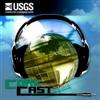USGS CoreCast
USGS Podcasts Home > CoreCast Home Page
Can't see Flash? Install Flash Player.
|
69
|

Hurricane Gustav; Hurricane Ike; Real-time storm surge sensors; Gulf coast impacts and satellite imagery; hurricane photography; Great California ShakeOut
Type: audio/mpeg
File Size: 4957633 bytes Duration: 5:05 Released: Fri, 3 Oct 2008 11:28:38 UTC |
Transcript:
[music fades in and out]
Welcome and thanks for tuning in to the U.S. Geological Survey's Hazards Round-Up for September 2008. I am Brian Campbell, your host.
We wrapped up last month's round-up with the Gulf Coast anxiously awaiting the arrival of Hurricane Gustav. Millions of Gulf residents had evacuated their homes, emergency response crews had been assembled, and the U.S. Geological Survey's mobile gages and storm surge sensors had been deployed. The Gulf was as prepared as it could have been for the arrival of Hurricane Gustav. The storm made landfall near Cocodrie, LA on the morning of September 1 as a strong Category 2 storm, with maximum sustained winds of 110 mph. However, Gustav quickly lost strength as it became a Category 1 storm just 4 hours later. By nightfall it had been reduced to a tropical storm, with winds of 60 mph. By early morning, the so-called "mother of all storms" had been downgraded to a mere tropical depression. Nonetheless, Gustav still managed to inflict $18 billion in damage and claim 43 lives in the United States alone.
USGS scientists had just a short break after Gustav before they were back to the Gulf to await the arrival of Hurricane Ike, the fifth hurricane of the 2008 Atlantic Hurricane Season. In preparation for Ike, USGS scientists installed similar storm surge sensors as those utilized during Gustav while the USGS Hurricane and Extreme Storm Research Group conducted pre-storm analyses of potential coastal change in five focus areas along the Gulf coastlines of Texas and Louisiana.
Hurricane Ike made landfall near Galveston, Texas on September 13. Like Gustav, Ike made landfall as a Category 2 storm with maximum sustained winds of 110 mph. However, Ike's sheer size (at one point boasting the largest ever recorded diameter) and storm surge destructive potential contributed to making it a particularly devastating hazard. Many residents along Texas' coastline failed to heed evacuation warnings and entire neighborhoods were obliterated. Hurricane Ike caused $27 billion worth of damage in the United States, making it the 3rd costliest storm in U.S. history behind Hurricane's Katrina and Andrew. 143 deaths have been attributed to Ike and many more people are still missing.
USGS scientists are continuing to analyze Ike's impact on the Gulf Coast. Satellite imagery and aerial photography is being collected to assess the impact on wetlands, coasts, and changes in the elevation. Water samples are being tested to determine the extent of salt water intrusion. Flooding and storm surge data is being documented while damaged gages are being replaced and repaired. Much of this data, including some stunning before-and-after photographs of a coastal neighborhood ravaged by the storm, is available online at coastal.er.usgs.gov/hurricanes/ike.
USGS scientists had their hands full this month with Gustav and Ike. Fortunately, there were no other major hazard events occurring elsewhere. However, there was a minor 4.0 magnitude earthquake that rattled the San Francisco Bay area on September 6. Which reminds me...
The Great Southern California ShakeOut is fast approaching! On November 13, millions of residents in California will be participating in the largest earthquake preparedness drill ever conducted in the United States. Currently, over 3.6 million people are registered to participate in the ShakeOut and that number continues to grow every day. The drill will represent the culmination of a week of events focused on earthquake preparedness. At the core of the ShakeOut is a study conducted by USGS scientist Dr. Lucy Jones and a team of over three hundred other scientists and engineers that analyzes the likely consequences of a magnitude 7.8 earthquake striking the San Andreas fault line in southern California. The results are staggering and can be viewed on the ShakeOut website, where you can also find all of the information that you need to know about this gigantic event. I encourage you to visit www.shakeout.org.
Well, that about wraps up September! Hazards-Round Up is a product of the U.S. Geological Survey, Department of the Interior. I'm Brian Campbell. Thanks for tuning in.
[music fades in and out]
Mentioned in this episode:
Music credit:
Dane Klima (CoreCast intro #7)


